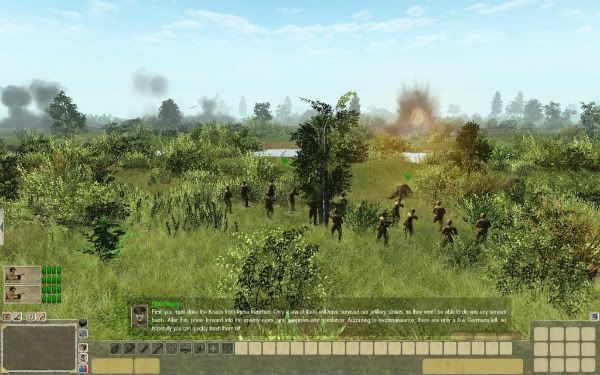This post has not been edited by the GamesBeat staff. Opinions by GamesBeat community writers do not necessarily reflect those of the staff.

Gunfire, soldiers running for cover, commanding officers screaming orders, and explosions. Oh, the explosions that rock the battlefield and — more importantly — the point of view. That shaky-cam popularized by Steven Spielberg's Saving Private Ryan and "perfected" to banality by Michael Bay that visually conveys the messy and tumultuous nature of conflict.
Men of War: Condemned Heroes, the latest in 1C Company's real-time strategy series for PC, at first seemed somewhat like a mish-mash of ideas borrowed from its predecessors: Assault Squad’s focus on pushing the front lines forward and Vietnam’s emphasis on guerrilla warfare (and all that that entails). But where Condemned Heroes really shines is through its exploration of the chaos of war.
I got my first taste of this during a mission called "A Hard Day," and the experience initially left me feeling confused and bitter. As my two-squad team advanced the Brest-Warsaw highway to drive the Germans from their trenches, my brothers-in-arms (computer-controlled allies) began acting erratically.
As we seized defensive positions, these men ran to and fro, with no destination in mind. When one soldier shot his rifle toward an empty ditch, the others followed suit. Nothing could stop them. They were locked in a feedback loop of their own ignorance. They spun in circles, firing in all directions. What the hell was going on with these men?

Their behavior seemed unintentional. Surely, developer 1C-Softclub didn't actually want soldiers running around aimlessly. Soldiers disregarding the stated mission objectives. Soldiers with an artificial intelligence that didn't appear equipped to handle the game mechanics. I mean, I've dealt with useless A.I. before (e.g., Civilization 5's inability to understand its own tactical rules), but this was just insane.
Much to my surprise, what I witnessed is actually a known feature. The A.I. in Condemned Heroes is "based on crowd psychology," says 1C-Softclub. Enlisted men in the field will react naturally to their surroundings. If others see a comrade fire in a particular direction, they'll point their barrels that way. They should stop shooting when all enemies are dead, but like real people, these virtual automatons are not perfect. 1C-Softclub set out to "make them living beings prone to error to some extent."
Ultimately, the developer is aiming for a "delicate balance between crazy, shooting mobs and robot squads" (described to me as an omnipotent A.I. that has perfect knowledge of what's happening during a mission). This goal reminded me of Soren Johnson's (who worked on Civs 3 and 4) 2010 Google Tech Talk on A.I., "Playing to Lose: A.I. and Civilization," where he outlined the differences between "good A.I." and "fun A.I."
Good A.I. is like chess. It plays the same game (i.e., abides by the same rules) as you. It doesn't have access to cheats, and nothing restricts the A.I. from taking any permissible action. In other words, Deep Blue doesn't steal pieces when you're not looking. Starcraft is another example. The A.I. manipulates the same units and abilities as you do, and you and the A.I. share the same end goal. Good A.I. plays to win.

Fun A.I., on the other side of this spectrum, plays to lose. The designer's focus is instead on providing a series of challenges to overcome, not to try and defeat you. Fun A.I. is asymmetrical: You and your computer adversary don't play by the same rules. The tower defense genre exemplifies this concept. A human in control of the creeps may decide that sitting back and pooling a large force together is a winning strategy, but that misses the point of the game, which is about being able to anticipate and recognize the creeps' movement patterns. Thus, such an option is left off-limits to the A.I.
Just as Johnson concluded that Civilization falls somewhere in between these two measures, so does Condemned Heroes. In fact, the game may even lean a little more toward the fun side. In Condemned Heroes, you're role-playing the real-world Soviet penal battalions of World War 2, which consisted of court-martialed officers stripped down to the lowest enlisted rank and handed the most dangerous tasks to accomplish. It's an uphill battle where the A.I. will always outnumber and outgun your meager forces.
But just the same, Condemned Heroes follows suit with the series' long-standing tactical rules set. Many of the same gameplay concepts, such as flanking, location-based damage, cover, and movement, apply to both you and the A.I. (whether ally or opponent) during a mission.
And that creates a more interesting spectacle than a heavily scripted, action-packed roller coaster ride. It also feels rather fresh in a genre that's widely known for its highly competitive edge. That your allies are a bit unpredictable adds some flavor. When you play "A Hard Day," your men might not snowball into the frenzy that I experienced. But the chance that the confusion of the battlefield could take over is always present. In Condemned Heroes, things can go to shit at any time.
